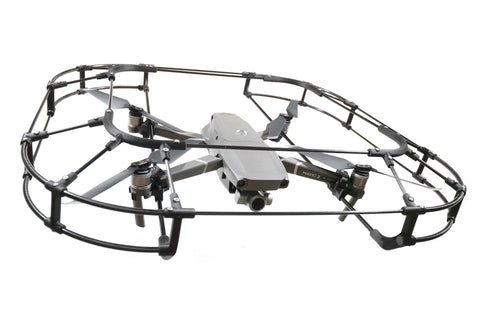
近年の技術発達によって大空を自在に舞うドローンは、人々の活動圏を三次元へ拡張し、今や様々な局面で活用され始めています。しかし、運用する場所によっては、接触事故の不安があります。ドローンが飛行の際に壁や天井に衝突し、一度制御を失ってしまえば、立て直すのは至難の業です。特にプロペラ部分への接触はなるべく避けたいところ。かといって全てを覆ってしまえば、機体が重くなってしまい、せっかくの機動性が失われてしまいます。
それを解決するのが、合同会社スカイブルー様が開発・販売する安全ドローンガードです。軽量で頑丈で、しかも用途によってカスタマイズが可能。それを陰から支えるのは、3Dプリンティング技術でした。
導入の背景:細かい形状の調整が可能・制作時間の短縮
今回ご回答いただいた上野様は、もともとは自動車産業界に長くいらっしゃいましたが、転じてドローンに関係する事業を立ち上げました。自動車業界全体に漠然とした限界を感じていたころ、ドローンという新しい技術に未来を感じます。そこで考えたのが、ドローンをより安定させて遠くに飛ばすために必要なものは何か、ということ。
不安が大きいのは、やはり接触です。どんなに丁寧に操作をしていても、突然の風や飛来物によって安定を欠く心配をぬぐえません。少なくとも、プロペラが衝突する可能性は減らさなければ……そう考えました。
まず、良いパーツが見つかりました。炭素繊維製の棒です。軽くてしなやかさと硬さを合わせ持ち、頑丈。空気の流れもほとんど邪魔することなく、ドローンガードとしては最適な材料です。メーカーと提携して、これを活用してガードを作成することに決まりました。
問題は、接合部のパーツです。棒だけでは形にならないため、棒と棒、棒とドローンを繋ぐパーツが必要となります。しかし、これを従来の方法である射出成形で作ろうとすると、非常に困難です。金型にプラスチックや金属を流し込んで作るならば、当然パーツごとにそれぞれの金型が必要になるため、結果的にかなりの種類に及びます。何より生産数から考えると、採算を取るのが困難でした。射出成形によって採算を取るためには、少なくとも3000個ずつは量産する必要がありましたが、現在の利用では、せいぜい1パーツにつき20個ほどの生産です。ドローンごとに形状を調整したり、今後新しい規格が次々出てくるだろうことを考えると、とても現実的ではありませんでした。

そこで目を付けたのが3Dプリンターによるパーツの製造です。細かく形状を調整することができ、パーツ1つから製造する事が出来ます。さらに、ドローンを覆うという用途の特性上、反転対称の形状をしたパーツの多いことが幸いでした。射出成形では個別に金型が必要ですが、3Dプリンターであればデータを反転させるだけで、そっくり対となるパーツが作成できるのです。
製造にかかる時間も申し分ありません。注文を受けてから2週間ほどで納品が可能……ということは、発注されてから生産に入れるので、在庫を抱える心配がありません。事業が大きくなってきても、単純に3Dプリンターを新たに増やせば、その分生産数を増やす事が出来ます。「3Dプリンティングは、ドローンガードに最適な方法だと思った」と、上野様は語ります。
運用方法と効果:軽さと頑丈さ
炭素繊維で骨組みを、3Dプリンターで接合パーツを、それぞれ作成することは決まりました。問題があと1つだけ残っています。それは直接の衝突や棒のゆがみを支える、接合パーツの頑丈さでした。
最初は、ABSなどの一般的なプラスチックを材料として使用していましたが、亀裂が入ったり割れてしまったりなどの破損が目立ちました。これでは、ドローンガードとしての本分が果たせません。上野様は頑丈な材料と、それで製造できる3Dプリンターを探しました。
やはり軽さと頑丈さを両立するのであれば、炭素繊維が適役です。採用された『Onyx(オニキス)』は、炭素配合ナイロン(ポリアミド)製の材料で、製造業向けの3DプリンターメーカーであるMarkforged社が提供する製品です。同社の3Dプリンター『Mark Two』ならば、造形物へさらに炭素繊維による層を挟みこめるため、アルミ並みの強度のパーツを作成する事が出来ます。ドローンガード事業を開始した当時、これら製造業向け3Dプリンターを日本国内でいち早く取り扱っていた企業こそ、3D Printing Corprationでした。
早速連絡を取り、データを共有して試作品を作成します。その結果、『Onyx』はそれだけでも頑丈であり、ドローンガードの接合部として十分に機能することがわかりました。小さな接合パーツのため『Onyx』だけで済むのは幸いでしたが、仮に今後さらなる強度を求められる段階になったとしても、炭素繊維の層を挟み込めば、かなりの質向上が狙えるというポテンシャルも安心材料となりました。3D Printing Corprationと『Onyx』・『Mark Two』をパートナーとして、軽く、頑強で、しかも様々な規格に対応可能なドローンガードがついに実現したのです。

今後の展望

今では、ドローンガードの事業は順調で、3台もの『Mark Two』が稼働しているそうです。「より良いプリンターが見つかってしまうと、以前の3Dプリンターは使わなくなってしまいますね」と上野様は笑います。
ガードの他にも、野外でドローンの活動圏内を覆うドローンネットなどを開発している合同会社スカイブルー様。今後の展望についてお聞きしました。
上野様によると、今後はドローンの巨大化が予想されるそうです。農業の農薬散布用や建設業界用など、これまでより大きく強力なドローンの活躍が見込まれているのです。それに伴って、プロペラ部分も大きく強化され、危険性も増していきます。「そうすると、ドローンガードはもはや本体のみを守るものではなく、人々の方を守るものになるんですね。見た目からしても、むき出しより覆ってある方が安全で、安心して使えるでしょう」と上野様は真摯に語ります。
また、それに連動してドローンガードの規格化も進んでいます。建設用ドローンともなると、法律の見直しのほか、ガードの強度保障も考えないといけません。合同会社スカイブルー様は、国と一緒にこの基準を作っているそうです。
そして最後に、プロペラ方式とは全く異なる、固定翼方式のドローン開発も進めているそうです。固定翼で滑空する場合、常に燃料の必要なプロペラ方式よりも、圧倒的な効率の向上が見込めます。つまり、長距離の運搬においてもドローンが活躍する未来が来るかもしれないのです。新たに社員として参加した小林様は、もともと自動車の設計デザインをされていました。その経験を活かして、飛行機の翼を参考にドローン用のパーツを3Dプリントしているそうです。3Dプリンターならパーツの拡大縮小も容易なため、模型を少しずつ大きくして、精度を高めているそうです。上野様は、このプロジェクトにも3D Printing Corporationに協力してもらい、DFAM™をはじめとした3Dプリンティングに関する豊富な知見を活かしてほしいと考えています。
とても楽しそうに、ドローンや3Dプリンティングの可能性について語る上野様。そしてそれを技術によって実現する小林様。彼ら合同会社スカイブルー様とともに、私たち3D Printing Corporationは、これからの未来を支えてゆきたいと願っています。
